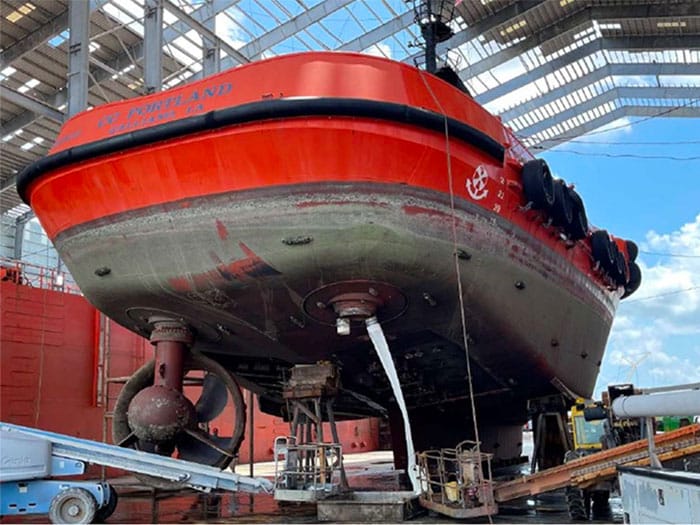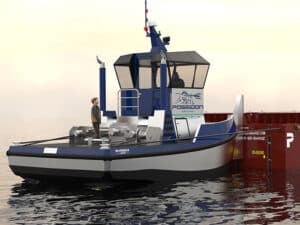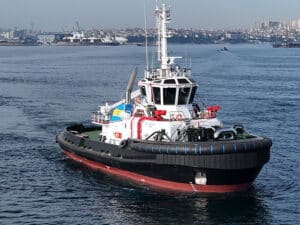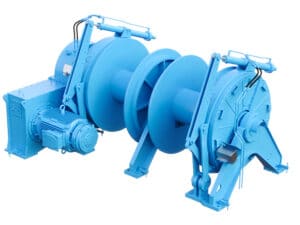
Excessive speed seen in expensive ASD tug grounding
Written by Nick Blenkey
The CC Portland in dry dock showing missing starboard Z-drive unit. [Photograph: USCG]
Excessive speed during a bow-to-bow harbor-assist maneuver led to the grounding of the ASD tugboat CC Portland in the Corpus Christi Ship Channel last year, the National Transportation Safety Board said Thursday.
It is the second marine casualty investigated by the NTSB in 2022 caused by excessive speed in azimuthing stern drive, or ASD, tugboats while in the center lead forward position. The NTSB continues to encourage owners and operators of ASD tugboats that perform bow-to-bow harbor-assist operations to set speed limits.
The NTSB report notes that, in 2013, the Dutch Safety Board investigated a casualty resulting in the capsizing of a tugboat while it attempted to make up to the bow of a large ferry. In its report, the Dutch Safety Board determined high speed to be one of the main causes of the capsizing. Following the casualty, a working group comprised of members of the International Tug Masters Association and the Nautical Institute conducted surveys of pilots, tugboat captains, and ship masters from around the world to determine what were considered safe speeds and safe procedures for tugboat operations. A large majority of survey respondents reported that their maximum speed while making up a tugboat to the bow of a vessel was 6 knots.
“The risk of a casualty during these operations with ASD tugboats increases with increasing speed,” NTSB investigators say in the final report on the CC Portland grounding. “Higher speed reduces the amount of reserve propulsion power available to the operator. If the tugboat moves out of position, the operator has less power to regain position as compared to the same maneuver at a lower ship transit speed.”
THE INCIDENT
According to the NTSB report, on August 7, 2022, at 1445 local time, the CC Portland owned by CC Tugs LLC and operated by Edison Chouest Offshore LLC, got underway from the Cheniere Corpus Christi LNG Terminal on the La Quinta Channel to assist the inbound LNG Fukurokuju with navigating through the Corpus Christi Ship Channel, into the La Quinta Channel, and to the terminal.
The tug grounded at 1625 local time outside the Corpus Christi Ship Channel, near Ingleside, Texas, while repositioning to secure a tow line on the bow of the inbound LNG carrier. No injuries were reported by the five crewmembers aboard the CC Portland or the 27 crewmembers aboard the LNG Fukurokuju. An estimated 4–5 gallons of diesel fuel were released from a hull breach on the tugboat.

DAMAGE
On August 8, when divers examined the CC Portland they discovered that the starboard Z-drive had been sheared off at the bolts connecting the drive to the flange. The port Z-drive was intact, but it had been fouled by the tugboat’s tow line. The divers found extensive damage to three starboard keel coolers. Additionally, they reported that one keel cooler support bracket had been ripped from the hull, leaving a hole measuring 4 inches by 3 inches in the no. 2 day fuel tank.
Damage to the CC Portland was estimated at $1.3 million.
PROBABLE CAUSE
The NTSB determined that the probable cause of the ASD tug grounding was the mate’s attempt to make up bow to bow with a liquefied natural gas carrier while the tugboat and liquefied natural gas carrier transited at a speed that was excessive for the advanced harbor-assist maneuver. Contributing to the casualty was the lack of a company policy regarding maximum allowable speed for bow assist maneuvers..
LESSONS LEARNED
The National Transportation Safety Board has previously noted the effect of speed on bow-to-bow harbor-assist operations in other investigations. The risk of a casualty during these operations with azimuthing stern drive (ASD) tugboats increases with increasing speed. Hydrodynamic forces around an assisted vessel’s bow increase exponentially with speed, while the amount of reserve propulsion power available to the tugboat operator decreases. Therefore, owners and operators of ASD tugboats that perform bow-to-bow harbor-assist operations should set speed limits for these maneuvers. These limits may vary for different classes of tugboats based on design. Tugboat operators should communicate these pre-determined speed limits to pilots and ship masters in command of the vessels that they are assisting before engaging in these maneuvers.




